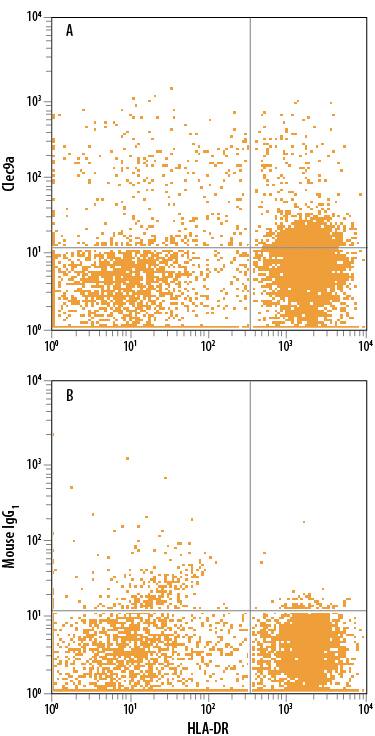Human CLEC9a Alexa Fluor® 700-conjugated Antibody
R&D Systems, part of Bio-Techne | Catalog # FAB6049N


Key Product Details
Species Reactivity
Validated:
Cited:
Applications
Validated:
Cited:
Label
Antibody Source
Product Specifications
Immunogen
Lys57-Val241
Accession # Q6UXN8
Specificity
Clonality
Host
Isotype
Scientific Data Images for Human CLEC9a Alexa Fluor® 700-conjugated Antibody
Detection of CLEC9a in HEK293 Human Cell Line Transfected with Human Clec9a and eGFP by Flow Cytometry.
HEK293 human embryonic kidney cell line transfected with human Clec9a and eGFP was stained with either (A) Mouse Anti-Human CLEC9a Alexa Fluor® 700-conjugated Monoclonal Antibody (Catalog # FAB6049N) or (B) Mouse IgG1Alexa Fluor 700 Isotype Control (Catalog # IC002N). View our protocol for Staining Membrane-associated Proteins.Detection of CLEC9a in Human Peripheral Blood Cells by Flow Cytometry.
Human peripheral blood cells gated on CD3-CD141+cells were stained with Mouse Anti-Human HLA-DR PE-conjugated Monoclonal Antibody (Catalog # FAB4869P) and either (A) Mouse Anti-Human CLEC9a Alexa Fluor® 700-conjugated Monoclonal Antibody (Catalog # FAB6049N) or (B) Mouse IgG1Alexa Fluor 700 Isotype Control (Catalog # IC002N). View our protocol for Staining Membrane-associated Proteins.Applications for Human CLEC9a Alexa Fluor® 700-conjugated Antibody
Flow Cytometry
Sample: HEK293 human embryonic kidney cell line transfected with human Clec9a and eGFP and human peripheral blood cells gated on CD3-CD141+ cells
Formulation, Preparation, and Storage
Purification
Formulation
Shipping
Stability & Storage
- 12 months from date of receipt, 2 to 8 °C as supplied.
Background: CLEC9a
CLEC9a (C-type lectin domain family 9 member A), also known as DNGR-1, is a type II transmembrane glycoprotein member of the C‑type lectin superfamily (1, 2). Mature human CLEC9a consists of a 35 amino acid (aa) cytoplasmic domain with an ITAM-like motif, a 21 aa transmembrane segment, and a 185 extracellular domain (ECD) that contains a stalk region and one C-type lectin domain (CTLD) (3‑5). Within the ECD, human CLEC9a shares 57% aa sequence identity with mouse and rat CLEC9a. Although the CTLD of CLEC9a structurally resembles that of other C-type lectins, it lacks the conserved residues that typically mediate calcium and carbohydrate binding. CLEC9a is expressed as a disulfide-linked homodimer of approximately 50 kDa N-glycosylated subunits (3, 5). Human CLEC9a expression is restricted to a subpopulation of BDCA-3+ conventional dendritic cells (cDC) and CD16- monocytes (3‑5). BDCA-3+ cDC are analagous to mouse CD8+ cDC which are specialized in antigenic cross-presentation in complex with MHC class I molecules (6). In mouse, CLEC9a is additionally expressed on plasmacytoid dendritic cells (4, 5). CLEC9a ligation enhances antigen uptake and processing, leading to presentation on MHC class I and cytotoxic T cell (CTL) priming (3‑5). In mouse, CLEC9a recognizes normally intracellular determinant(s) of necrotic cells and mediates their uptake by the dendritic cell (7). The subsequent antigenic cross-presentation to CTL is important for clearing necrotic cellular debris (7). CLEC9a signaling triggers activation of the tyrosine kinase Syk (3, 7).
References
- Huysamen, C. and G.D. Brown (2009) FEMS Microbiol. Lett. 290:121.
- Geijtenbeek, T.B.H. et al. (2004) Annu. Rev. Immunol. 22:33.
- Huysamen, C. et al. (2008) J. Biol. Chem. 283:16693.
- Caminschi, I. et al. (2008) Blood 112:3264.
- Sancho, D. et al. (2008) J. Clin. Invest. 118:2098.
- Dudziak, D. et al. (2007) Science 315:107.
- Sancho, D. et al. (2009) Nature 458:899.
Long Name
Alternate Names
Gene Symbol
UniProt
Additional CLEC9a Products
Product Specific Notices for Human CLEC9a Alexa Fluor® 700-conjugated Antibody
This product is provided under an agreement between Life Technologies Corporation and R&D Systems, Inc, and the manufacture, use, sale or import of this product is subject to one or more US patents and corresponding non-US equivalents, owned by Life Technologies Corporation and its affiliates. The purchase of this product conveys to the buyer the non-transferable right to use the purchased amount of the product and components of the product only in research conducted by the buyer (whether the buyer is an academic or for-profit entity). The sale of this product is expressly conditioned on the buyer not using the product or its components (1) in manufacturing; (2) to provide a service, information, or data to an unaffiliated third party for payment; (3) for therapeutic, diagnostic or prophylactic purposes; (4) to resell, sell, or otherwise transfer this product or its components to any third party, or for any other commercial purpose. Life Technologies Corporation will not assert a claim against the buyer of the infringement of the above patents based on the manufacture, use or sale of a commercial product developed in research by the buyer in which this product or its components was employed, provided that neither this product nor any of its components was used in the manufacture of such product. For information on purchasing a license to this product for purposes other than research, contact Life Technologies Corporation, Cell Analysis Business Unit, Business Development, 29851 Willow Creek Road, Eugene, OR 97402, Tel: (541) 465-8300. Fax: (541) 335-0354.
For research use only
